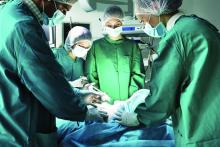Almost three-quarters of uninsured adults admitted for traumatic injury are at risk of catastrophic health expenditures (CHEs), according to a large retrospective study from a national patient database.
Since enactment of the Affordable Care Act in 2010, the number of uninsured individuals has dropped substantially, but there remains a large population of younger adults, many from low-income areas, who still are not covered. The Centers for Disease Control and Prevention reported in 2015 that 12.8% of individuals aged 18-64 years were uninsured. The financial impact of a traumatic injury is likely to be significant for those paying out of pocket, but the question of who is at risk and to what degree is understudied, according to John W. Scott, MD, of Brigham and Women’s Hospital, Boston, and his colleagues.
“Defining populations at risk of financial catastrophe after medical expense is a necessary step towards elucidating the effect of health care reforms intended to increase access to healthcare through insurance expansion,” they wrote in the Annals of Surgery (2017 Apr 7. doi: 10.1097/SLA.0000000000002254).
Dr. Scott and his colleagues analyzed trauma diagnoses in adults aged 18-64 years from Nationwide Inpatient Sample 2007-2011. They used the U.S. Census data to estimate post-subsistence income (income remaining after paying for food) and hospital charges for trauma diagnoses. The sample of 117,502 patient encounters was weighted to represent 579,683 trauma patients in the national database.
CHEs were defined conservatively as expenses that exceed 40% of a patient’s post-subsistence income; they also applied a lower threshold of CHEs – 10% of a patient’s entire income – without accounting for subsistence needs.
The investigators wanted to look at who was at greatest risk for CHEs and used the Census data to sort trauma patients by residential zip code to identify the distribution of income in the sample.
Costs to trauma patients varied by injury severity score (ISS) and by income quartile. Patients in the 25th income quartile paid less for their treatment, even accounting for ISS, but despite this difference, poorer patients were at a much greater risk for CHEs.
The median charge for all of these uninsured trauma patients was $27,420. Those trauma patients in the 25th percentile of income were charged an average of $15,196, while those in 75th quartile were charged $49,696. The difference in costs also was evident when comparing patients in different ISS categories: for ISS 9-15, median trauma costs for the lower-quartile patients was $31,095, but costs for the upper quartile patients was $52,639.
With cost, income, and injury severity data, the investigators found that overall the proportion of adults aged 18-64 years at risk for CHEs was 70.8% (95% confidence interval, 70.7%-71.1%). Subpopulations (ethnicity/race, age, sex) were within a few percentage point of each other.
Risk of CHEs varied widely by income quartile and ISS. Uninsured trauma patients in the highest income quartile had a 52.9% risk of CHEs, compared with 77.5% of those in the lowest-income quartile. Overall, 81.8% of patients with ISS greater than 24 were at risk for CHEs. In addition, the study found that patients treated at large or urban teaching hospitals – those most likely to handle the most-severely injured patients – were at a heightened risk for CHEs.
When the investigators conducted the same analysis with a lower threshold of CHEs (10% of income, not including subsistence expenses), the overall risk for uninsured trauma patients for catastrophic health expenses was more than 90%.
“Trauma patients are at particularly high risk for CHE because trauma disproportionately affects uninsured patients with little disposable income and because trauma injuries commonly affect multiple organ systems and incur expensive, multispecialty care,” Dr. Scott and his colleagues wrote. “Large unpaid medical debts may have longstanding impacts on patients’ financial well-being, affecting credit ratings and overall financial solvency. These financial stresses may be further compounded by an inability to return to work caused by injury.”
Dr. Scott and his coauthors added that having health insurance does not entirely eliminate the risk for CHEs and that individuals in the lower income brackets covered by employer-based plans or Medicaid had difficulty paying medical bills.
Only hospital costs were examined, which may not reflect forgiven debts, the investigators noted. In addition, the costs may be underreported because they do not include physician charges, postacute care, home health care, or rehabilitation. Incomes were estimated by zip code analysis, which may misclassify some individuals.
“Efforts are needed to ensure that the lifesaving care provided by our highly coordinated trauma systems do not have the unintended consequence of curing patients into destitution,” Dr. Scott and his colleagues wrote
The authors declared no conflicts of interest.

